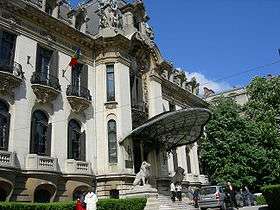Cantacuzino family

The Cantacuzino or Cantacuzène family, a princely family of Wallachia, Moldavia and Russia, claims descent from a branch of the Greek Kantakouzenos family, descended from the Byzantine Emperor[1] John VI Kantakouzenos (reigned 1347–1354). In Russia, the family received princely (Knyaz, as opposed to Velikij Knyaz) status. In 1944 Prince Ștefan Cantacuzino settled in Sweden, where his descendants form part of the unintroduced nobility of the country.[2]
Origin of the family
Members of the family claim that the genealogical links between the Byzantine Greek and Romanian branches of the family have been extensively researched.[3] The family first appears among the Phanariotes in the late 16th century, with Michael "Şeytanoğlu" Kantakouzenos, after a gap of over a century from the Fall of Constantinople.[4] Whether the family is indeed linked to the Byzantine imperial house of Kantakouzenos is disputed, as it was usual among wealthy Greeks of the time to assume Byzantine surnames and claim descent from the famous noble houses of their Byzantine past.[4] The eminent Byzantinist Steven Runciman considered the latter-day Kantakouzenoi "perhaps the only family whose claim to be in the direct line from Byzantine Emperors was authentic",[5] but according to the historian Donald Nicol, "Patriotic Rumanian historians have indeed labored to show that ... of all the Byzantine imperial families that of the Kantakouzenos is the only one which can truthfully be said to have survived to this day; but the line of succession after the middle of the fifteenth century is, to say the least, uncertain."[6]
The origin of the Byzantine family can be traced to Smyrna. The Greek scholar Konstantinos Amantos suggested at "Kantakouzenos" derives from κατὰ-κουζηνᾶν or κατὰ-κουζηνόν, ultimately from the locality of Kouzenas, a name for the southern part of Mount Sipylon near Smyrna. Donald Nicol agrees with this theory, and lists some connections the Kantakouzenoi had with the locale in the 11th and 13th centuries.[7]
Origin of the Romanian branch

The Greek Kantakouzenos family had been active in Constantinople and Greece during "the Greek war of independence",[8] however several branches of the original Greek family were created via the migrations and establishment of Kantakouzenos family members to different parts of Europe. Two of those new branches were the Romanian (Wallachian and Moldavian) Cantacuzino branch as well as the Russian branch (which is an offshoot of the Romanian-Moldavian one). As a consequence of the Russian Revolution and the Soviet occupation of Romania after World War II, (between 1944 and 1947) the last two branches now mostly live in Western Europe and North America.[3]
According to Jean-Michel Cantacuzène and Mihail Sturdza, the origin of the Cantacuzino family in Romania is traced to Andronikos Kantakouzenos (died 1601), (also known as Andronik)[1] a Greek financier from Constantinople, son of the "Prince of the Greeks" Michael "Şeytanoğlu" Kantakouzenos.[3] Andronikos had among his several sons two who became "boyars" in what today is Romania and founded the yet-surviving new branches of Cantacuzino:
- "boyar" Georgios 'Iordaki' Kantakouzenos became forefather of the Moldavian branch, which soon branched to Cantacuzino-Deleanu and Cantacuzino-Pasceanu.
- "boyar" Konstantinos 'Kostaki' Kantakouzenos married an heiress (daughter) of the late reigning prince Radu Șerban, onetime ruler of Wallachia, and they founded the Wallachian branches which soon clashed against the Ghica family over power.
Notable members
- Bella Rosetti (Cantacuzino), wife of Lascaris Rosetti, high chancellor of the Patriarchate of Constantinople and Mother of Constantin Rosetti and Prince Antoine Ruset Voda
- Alexandrina Cantacuzino, political activist
- Alexandros Kantakouzinos, magnate and politician
- Alexandru Cantacuzino, government minister
- Constantin Cantacuzino, high official in Wallachia
- Constantin Cantacuzino, World War II flying ace
- Elena Cantacuzino, mother of Șerban Cantacuzino
- Gheorghe Grigore Cantacuzino, Prime Minister of Romania
- Grigore Gheorghe Cantacuzino, Mayor of Bucharest
- Ioan Cantacuzino, physician and scientist
- Julia Dent Cantacuzène Spiransky-Grant, granddaughter of Ulysses S. Grant, author
- Matei B. Cantacuzino, Mayor of Iași, Education Minister and Justice Minister
- Mihail G. Cantacuzino, Mayor of Bucharest and Justice Minister
- Prince Mikhail Cantacuzène, Russian diplomat
- Pârvu Cantacuzino, Ban of Oltenia, the leader of an anti-Ottoman rebellion in 1769
- Scarlat Cantacuzino, poet and diplomat
- Șerban Cantacuzino, Voivode of Wallachia
- Ștefan Cantacuzino, Voivode of Wallachia
See also
References
- 1 2
 Chisholm, Hugh, ed. (1911). "Cantacuzino". Encyclopædia Britannica (11th ed.). Cambridge University Press.
Chisholm, Hugh, ed. (1911). "Cantacuzino". Encyclopædia Britannica (11th ed.). Cambridge University Press. - ↑ http://www.svd.se/kultur/utlandska-slakter-med-stamtavla_416401.svd
- 1 2 3 Jean-Michel Cantacuzène, Mille ans dans les Balkans Éditions Christian Paris (1992) ISBN 2-86496-054-0.
- 1 2 Finlay, George (1856). The History of Greece under Othoman and Venetian Domination. Edinburgh and London: William Blackwood and Sons. pp. 188–189.
- ↑ Runciman, Steven (1985). The Great Church in Captivity: A Study of the Patriarchate of Constantinople from the Eve of the Turkish Conquest to the Greek War of Independence. Cambridge: Cambridge University Press. p. 197. ISBN 0-521-31310-4.
- ↑ Nicol, The Byzantine Family of Kantakouzenos (Cantacuzenus), ca. 1100-1460: A Genealogical and Prosopographical Study (Washington, D.C.: Dumbarton Oaks, 1968), p. v
- ↑ Nicol, The Byzantine Family of Kantakouzenos (Cantacuzenus), ca. 1100-1460: A Genealogical and Prosopographical Study (Washington, D.C.: Dumbarton Oaks, 1968), p. viiif
- ↑ http://www.agiasofia.com/1821/fort1821/struggle3.html
External links
| Wikimedia Commons has media related to Cantacuzino family. |
| Wikisource has the text of the 1911 Encyclopædia Britannica article Cantacuzino. |
| ||||||||||||||||||||||||||
